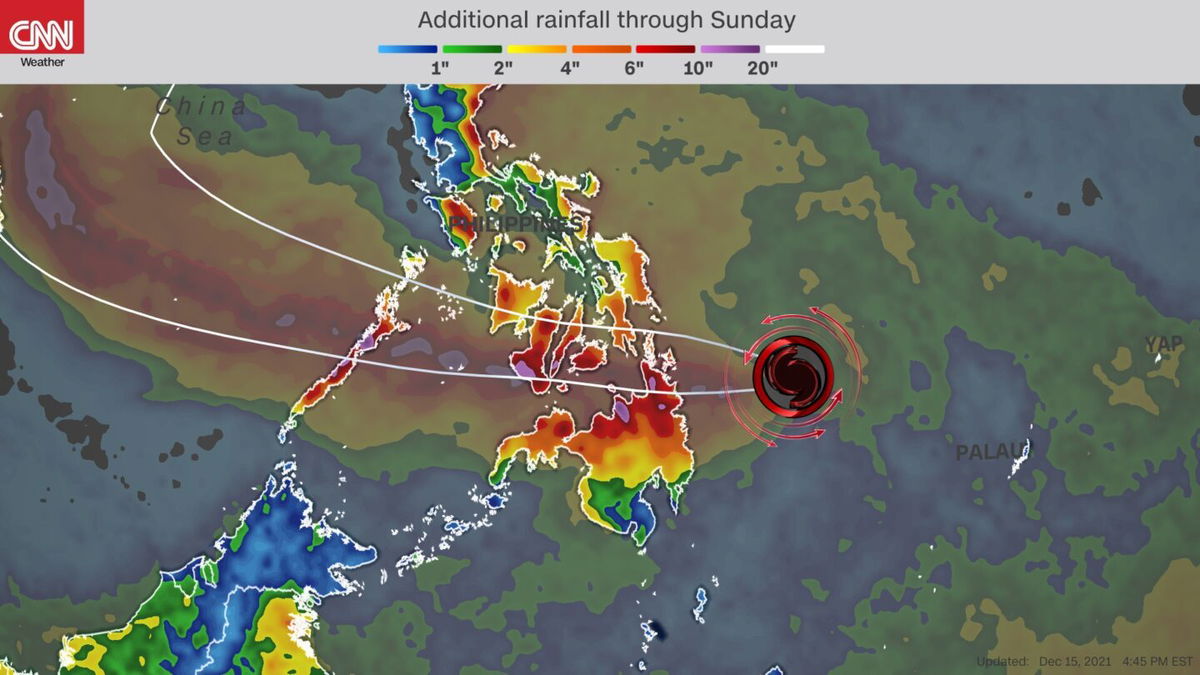Typhoon Rai rapidly strengthens as it nears the Philippines

Favorable conditions across the region
By Taylor Ward, CNN Meteorologist
Typhoon Rai is rapidly strengthening east of the southern Philippines and may be on the verge of becoming a super typhoon. The storm is on track to slam the southern and central portions of the country Thursday.
Rai currently has sustained winds of 215 kph (130 mph), making it the equivalent of a Category 4 hurricane on the Saffir-Simpson Hurricane Wind Scale.
Favorable conditions across the region, including very warm ocean waters and low wind shear, led to the storm strengthening from a tropical storm to a potentially catastrophic, high-end typhoon in the past 24 hours.
Additional strengthening is expected, and the current forecast from the Joint Typhoon Warning Center is for Rai to reach 260 kph (160 mph) at landfall. This would make Rai equivalent to a Category 5 hurricane or a super typhoon.
In the Philippines, the storm is known as Odette and is being monitored locally by the Philippine Atmospheric, Geophysical and Astronomical Services Administration (PAGASA).
The outer bands of the storm are already spreading rain into the southern and central regions of the country and conditions will deteriorate quickly in the coming hours.
It is already Thursday in the Phillippines, and from Thursday morning through Friday morning, the rains are expected to be “heavy to intense and at times torrential,” PAGASA said in its forecast bulletin early Thursday morning.
More than 250 mm (10 inches) of rain will fall across portions of Mindanao and the Visayas. The intense rain is expected to cause widespread flooding, flash flooding, and landslides in higher terrain.
PAGASA has already issued Tropical Cyclone Warning Signal 3 for high winds in southern portions of the Visayas and northern Mindanao. As the storm nears landfall, Thursday afternoon locally, PAGASA may increase the warning signal to 4 or even 5 — the top of their chart.
In addition to the strong winds, flooding and landslides, coastal regions will be on alert for three to four meters of storms surge and shipping vessels will face extremely rough seas over the next several days.
December storms are not uncommon
In the West Pacific, there is no defined “season” for tropical systems as there are in other basins like the North Atlantic (June 1 to November 30). While activity peaks in the late summer to early autumn, storms can occur in any month of the year.
The Philippines is no stranger to catastrophic storms in December. In the last decade, numerous intense and deadly storms have impacted the region.
In 2011, Tropical Storm Washi killed well over 1,000 people in the southern Philippines and never made it to typhoon status. The storm was comparatively weak, but dumped massive amounts of rainfall, leading to devastating flash flooding and landslides during the overnight hours while people were sleeping.
Just a year later, in December 2012, Bopha also hit the southern Philippines region of Mindanao. Bopha was much stronger than Washi, hitting the region as a super typhoon, and killing more than 1,000 people.
The Philippines was also struck by strong and deadly typhoons in December 2014 (Hagupit) and 2016, when Typhoon Nockten struck on Christmas Day.
The-CNN-Wire
™ & © 2022 Cable News Network, Inc., a WarnerMedia Company. All rights reserved.



